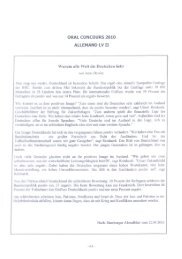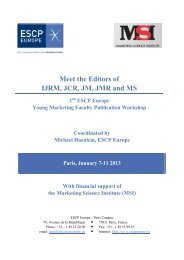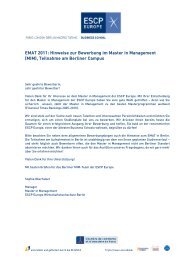WP 53_Jacob_neu - ESCP Europe Business School
WP 53_Jacob_neu - ESCP Europe Business School
WP 53_Jacob_neu - ESCP Europe Business School
Create successful ePaper yourself
Turn your PDF publications into a flip-book with our unique Google optimized e-Paper software.
in the different industrial buying situations with higher bars signaling greater<br />
importance and vice versa.<br />
Co-Production<br />
High<br />
Low<br />
Customer-centric<br />
Market Offerings<br />
� Well-defined customer needs<br />
� High degree of standardization<br />
� “People-based”<br />
� Experience attributes<br />
� Price = Value<br />
� Regular purchased, in high quantities<br />
LH<br />
Commodities<br />
� Well defined customer needs<br />
� High degree of standardization<br />
� Search attributes<br />
� Price > Value<br />
� Regular purchased, in high quantities<br />
Low<br />
HH<br />
LL HL<br />
Market-Offering<br />
Complexity<br />
Complex Solutions<br />
� Highly abstract customer needs<br />
� High degree of customization<br />
� “People-based“<br />
� Experience & credence attributes<br />
� Value > Price<br />
� Irregular purchased, in low quantities<br />
Supplier-centric<br />
Market Offerings<br />
� Abstract customer needs<br />
� High degree of standardization<br />
� Experience & credence attributes<br />
� Value > Price<br />
� Irregular purchased, in low quantities<br />
High<br />
Fig. 1: A Market-offering complexity/Co-creation Typology for Industrial Market<br />
Offerings<br />
4.1 High Market-offering Complexity/High Co-creation (HH):<br />
Complex Solutions<br />
We labeled the fourth quadrant “complex solutions.” Complex solutions are<br />
characterized by both high degrees of perceived market-offering complexity and<br />
co-creation. This kind of market offerings is gaining prominence in the industry;<br />
for instance, technology companies have shifted (e.g., IBM by acquiring<br />
PriceWaterhousCoopers) or are in the process (e.g., HP acquired EDS, Dell is<br />
about to acquire Parot Systems) of shifting from competing based on product<br />
differrentiation to competiting based on solution customization (<strong>Business</strong>week<br />
2009; Srivastava, Shervani, and Fahey 1999). Dell for instance gives its<br />
salesforce incentives “to offer a broad range of solutions, instead of just<br />
hardware” (Edwards 2009, p.40).<br />
We draw from qualitative research by Tuli, Kohli, and Bharadwaj (2007)<br />
where a solution provider states that “one of the key aspects of solutions is their<br />
complexity as compared to most products. This complexity can create problems<br />
as oftentimes, it’s not clear what are the requirements, what are the goals, etc.<br />
This is especially important for solutions due to the duration of solution<br />
development and implementation” (p.9).<br />
9

















